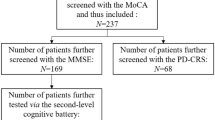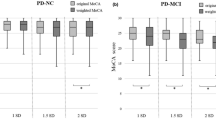Abstract
Prevalence of mild cognitive impairment (MCI) in Parkinson’s disease (PD) is variable likely due to methodological differences in classification criteria and lack of consensus about neuropsychological tests used for cognitive profiling. The main objective of our study was to identify the most suitable neuropsychological tests and determine their screening and diagnostic cutoff scores for PD-MCI. A series of 104 consecutive PD patients performed an extensive neuropsychological evaluation. Individual test values were converted into Z-scores using relative published normative data. According to published criteria, PD patients were categorized as PD-CNT (PD without cognitive impairment), PD-MCI (patients performing −1.5 SDs below the mean score in at least one cognitive domain), and PDD. We used receiver operating characteristic (ROC) curves and K-means clustering analyses to calculate the best discriminating power of each neuropsychological tests in detecting PD-MCI. PD patients were categorized as follows: 55 PD-CNT (53 %), 34 PD-MCI (33 %), and 15 PDD (14 %). PD-MCI had lower education, longer disease duration and greater frequency of hallucinations than PD-CNT. We found that only the Trail Making test, Rey-Osterrieth Complex Figure Test (ROCF) copy, Frontal Assessment Battery (FAB), Digit Span Backward, and Rey’s word auditory verbal learning test (RVLT) immediate recall reached significant screening and diagnostic validity in predicting PD-MCI (AUC 0.705–0.795) with cutoff scores calculated by ROC analyses lying within normal range for normative data. Specific neuropsychological tests covering verbal memory, attention/set-shifting, and visual-spatial deficits are the best predictors of MCI in PD if valid cutoff scores are used. These results have consequences for cognitive diagnosis and potentially in establishing the rate of PD cognitive decline.

Similar content being viewed by others
References
Aarsland D, Andersen K, Larsen JP et al (2001) Risk of dementia in Parkinson’s disease: a community-based, prospective study. Neurology 56(6):730e6
Aarsland D, Andersen K, Larsen JP et al (2003) Prevalence and characteristics of dementia in Parkinson disease: an 8 year prospective study. Arch Neurol 60(3):387–392
Aarsland D, Kvaløy JT, Andersen K et al (2007) The effect of age of onset of PD on risk of dementia. J Neurol 254(1):38–45
Aarsland D, Bronnick K, Williams-Gray C et al (2010) Mild cognitive impairment in Parkinson disease: a multicenter pooled analysis. Neurology 75(12):1062–1069
Apollonio I, Leone M, Isella V et al (2005) The frontal assessment battery (FAB): normative values in an Italian population sample. Neurol Sci 26(2):108–116
Baldo JV, Schwartz S, Wilkins D et al (2006) Role of frontal versus temporal cortex in verbal fluency as revealed by voxel-based lesion symptom mapping. J Int Neuropsychol Soc 12(6):896–900
Caffarra P, Vezzadini G, Dieci F et al (2002a) Rey-Osterrieth complex figure: normative values in an Italian population sample. Neurol Sci 22:443–447
Caffarra P, Vezzadini G, Dieci F et al (2002b) Una versione abbreviata del test di Stroop. Dati normativi nella popolazione italiana. Nuova Rivista di Neurologia 12:111–115
Caffarra P, Gardini S, Zonato F et al (2011) Italian norms for the Freedman version of the Clock Drawing Test. J Clin Exp Neuropsychol 33(9):982–988
Carlesimo GA, Caltagirone C, Gainotti G et al (1996) The mental deterioration battery: normative data, diagnostic reliability and qualitative analyses of cognitive impairment. Eur Neurol 36(6):378–384
Caviness JN, Driver-Dunckley E, Connor DJ et al (2007) Defining mild cognitive impairment in Parkinson’s disease. Mov Disord 22(9):1272–1277
Emre M, Aarsland D, Brown R et al (2007) Clinical diagnostic criteria for dementia associated with Parkinson’s disease. Mov Disord. 22(12):1689–1707
Folstein MF, Folstein SE, McHugh PR (1975) “Mini-mental state”. A practical method for grading the cognitive state of patients for the clinician. J Psychiatr Res 12(3):189–198
Foltynie T, Brayne CE, Robbins TW et al (2004) The cognitive ability of an incident cohort of Parkinson’s patients in the UK. The CamPaIGN study. Brain 127(Pt 3):550–560
Giovagnoli AR (1996) Del Pesce M., Mascheroni S., et al., Trail Making Test: normative values from 287 normal adult controls. Ital J Neurol Sci 17(4):305–309
Gjerstad MD, Aarsland D, Larsen JP (2002) Development of daytime somnolence over time in Parkinson’s disease. Neurology 58(10):1544–1546
Halliday G, Hely M, Reid W et al (2008) The progression of pathology in longitudinally followed patients with Parkinson’s disease. Acta Neuropathol 115(4):409–415
Hobson P, Meara J (2004) Risk and incidence of dementia in a cohort of older subjects with Parkinson’s disease in the United Kingdom. Mov Disord 19(9):1043–1049
Hoops S, Nazem S, Siderowf AD et al (2009) Validity of the MoCA and MMSE in the detection of MCI and dementia in Parkinson disease. Neurology 73(21):1738–1745
Hughes TA, Ross HF, Musa S et al (2000) A 10 year study of the incidence of and factors predicting dementia in Parkinson’s disease. Neurology 54(8):1596–1602
Janvin CC, Larsen JP, Salmon DP et al (2006) Cognitive profiles of individual patients with Parkinson’s disease and dementia: comparison with dementia with lewy bodies and Alzheimer’s disease. Mov Disord 21(3):337–342
Lezak MD, Howieson DB, Loring DW et al (2004) Neuropsychological Assessment, 4th ed. Oxford University Press, New York
Litvan I, Goldman JG, Tröster AI et al (2011) Diagnostic criteria for mild cognitive impairment in Parkinson’s disease: movement disorder society task force guidelines. Mov Disord 27(3):349–356
Mondini S, Mapelli D, Vestri A et al (2003) L’esame neuropsicologico breve ENB. Milano, Raffaello Cortina, p 144
Muslimovic D, Post B, Speelman JD, Schmand B (2005) Cognitive profile of patients with newly diagnosed Parkinson disease. Neurology 65(8):1239–1245
Novelli G, Papagno C, Capitani E et al (1986) Tre test clinici di ricerca e produzione lessicale: taratura su soggetti normali. Archo Psicol Neurol Psichiat 47:477–506
Pagonabarraga J, Kulisevsky J, Llebaria G et al (2008) Parkinson’s disease-cognitive rating scale: a new cognitive scale specific for Parkinson’s disease. Mov Disord 23(7):998–1005
Petersen RC, Smith GE, Waring SC et al (1999) Mild cognitive impairment: clinical characterization and outcome. Arch Neurol. 1999 Mar, 56(3), pp. 303–8. Erratum in. Arch Neurol 56(6):760
Riedel O, Klotsche J, Spottke A et al (2008) Cognitive impairment in 873 patients with idiopathic Parkinson’s disease. Results from the German Study on Epidemiology of Parkinson’s Disease with Dementia (GEPAD). J Neurol 255(2):255–264
Spinnler H, Tognoni G (1987) Standardizzazione e taratura italiana di test neuropsicologici. Ital J Neurol Sci 6(Suppl. 8):1–120
Tomlinson CL, Stowe R, Smita P et al (2010) Systematic review of levodopa dose equivalency reporting in Parkinson’s disease. Mov Disord 25(15):2649–2685
Verbaan D, Marinus J, Visser M et al (2007) Cognitive impairment in Parkinson’s disease. J Neurol Neurosurg Psychiatry 78(11):1182–1187
Weintraub D, Moberg PJ, Culbertson WC et al (2004) Evidence for impaired encoding and retrieval memory profiles in Parkinson disease. Cogn Behav Neurol 17(4):195–200
Whittington CJ, Podd J, Stewart-Williams S (2006) Memory deficits in Parkinson’s disease. J Clin Exp Neuropsychol 28(5):738–754
Williams-Gray CH, Evans JR, Goris A et al (2009) The distinct cognitive syndromes of Parkinson’s disease: 5 year follow-up of the CamPaIGN cohort. Brain 132(Pt 11):2958–2969
Author information
Authors and Affiliations
Corresponding author
Electronic supplementary material
Below is the link to the electronic supplementary material.
Rights and permissions
About this article
Cite this article
Biundo, R., Weis, L., Pilleri, M. et al. Diagnostic and screening power of neuropsychological testing in detecting mild cognitive impairment in Parkinson’s disease. J Neural Transm 120, 627–633 (2013). https://doi.org/10.1007/s00702-013-1004-2
Received:
Accepted:
Published:
Issue Date:
DOI: https://doi.org/10.1007/s00702-013-1004-2




